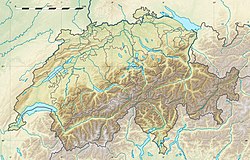Top Qs
Timeline
Chat
Perspective
Bagnoud Observatory
Observatory From Wikipedia, the free encyclopedia
Remove ads
François-Xavier Bagnoud Observatory (French: Observatoire François-Xavier Bagnoud) is an astronomical observatory located above the village of Saint-Luc in Valais, Switzerland, close to the top of the funicular, at a height of 2,200 m (7,200 ft).[1][2][3] It is a non-profit organisation funded by Association François-Xavier Bagnoud and named after a Swiss rescue pilot.[4][5]
Opened in 1995, the observatory was established to promote astronomy education and public engagement. Its facilities are accessible to schools, amateur astronomers, and visitors, supporting both hands-on learning and public demonstrations in daytime and nighttime conditions.[6] Unlike most mountain observatories equipped with professional instruments, it is not reserved solely for scientists but is open to the public.[4]
The observatory has 60 cm (24 in) and 15 cm (5.9 in) telescopes, as well as a heliostat,[2] a weather station,[7] a planetarium,[2] and a planet trail between the observatory and the funicular.[8] In 2007, it contributed to the detection of Gliese 436 b, a Neptune-sized exoplanet composed largely of hot ice.[5]
Remove ads
History
In 2007, the observatory contributed to the discovery of Gliese 436 b, a planet located 30 light years away. Using its 24-inch telescope, astronomers detected a dimming of the host star’s light, indicating a planetary transit. The observatory’s director described it as the first time a non-gaseous extrasolar planet had both its mass and size precisely measured, calling the discovery “a great step towards the search for other planets that resemble Earth”.[5]
Remove ads
References
Wikiwand - on
Seamless Wikipedia browsing. On steroids.
Remove ads



